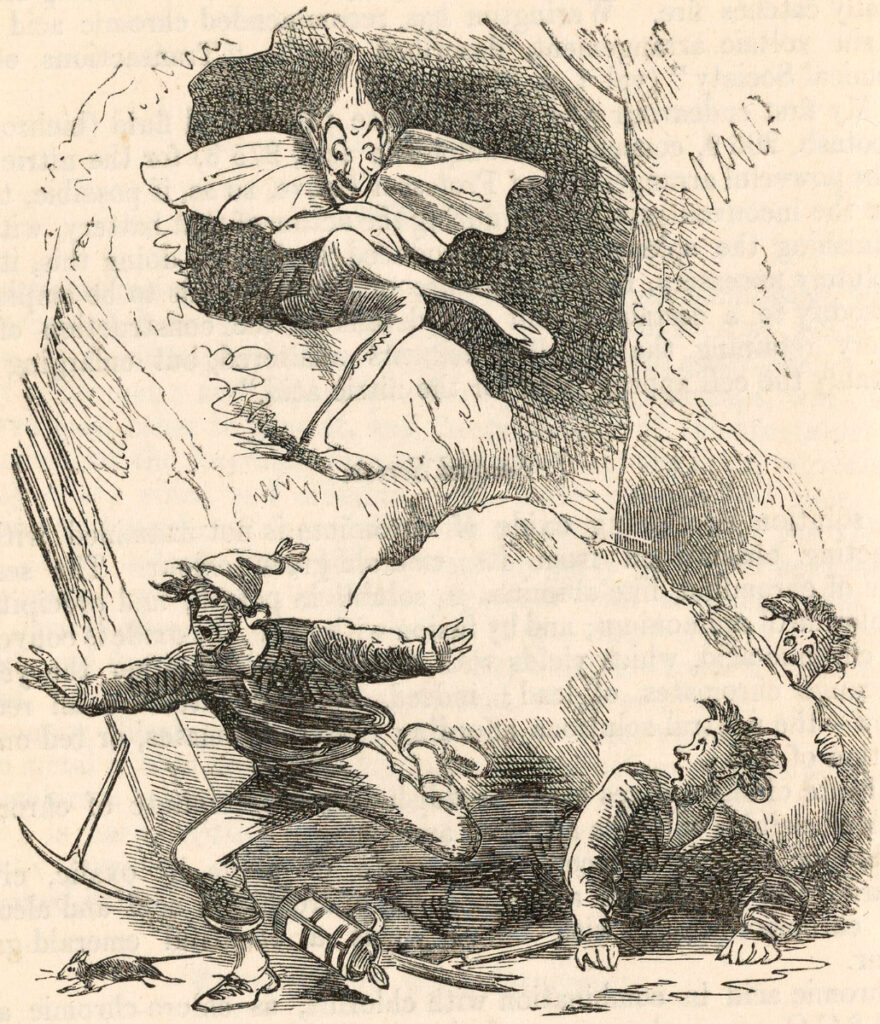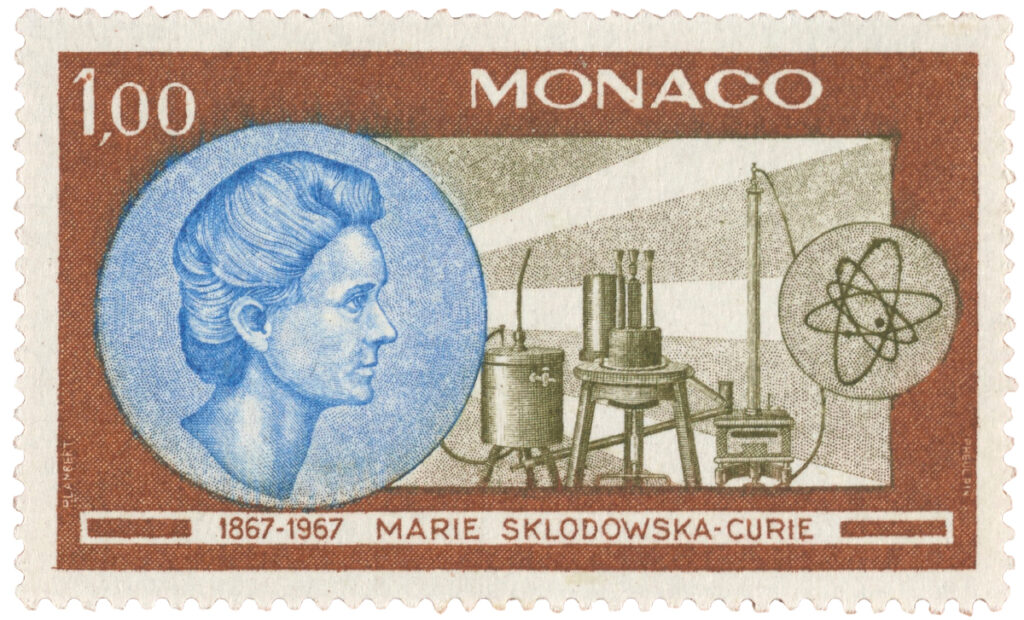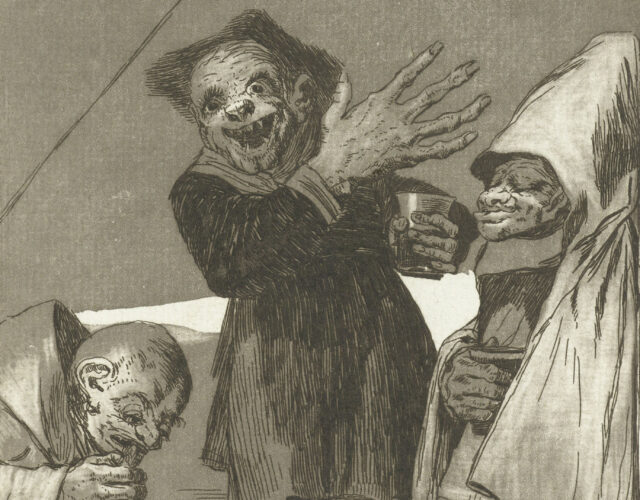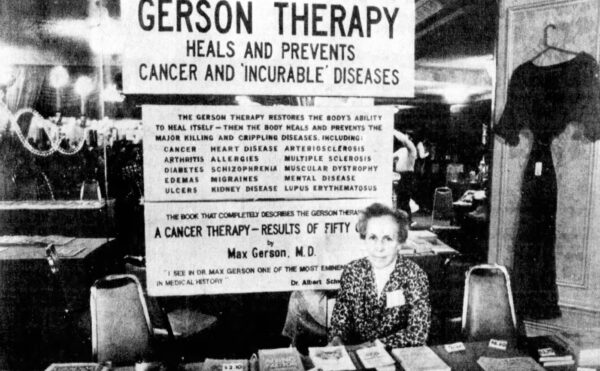Peter Wothers. Antimony, Gold, and Jupiter’s Wolf: How the Elements Were Named. Oxford University Press, 2020. 304 pp. $26.
Mines are spooky places: dark, echoing, labyrinthine, home to unfamiliar sounds and smells. You’re far underground and frequently at the mercy of what you cannot see or anticipate—falling rocks, poisonous gases. And if we’re thinking about mines slighting, there is literally no place on earth darker: it is total, all-encompassing, relentless darkness. You’d forgive miners for being a little superstitious.
In 1549 Georgius Agricola—best known for his iconic On the Nature of Metals—published a book on subterranean animals, including the various demons thought to be found in mines. “Some are cruel and terrible to behold, and these annoy and hurt the miners,” explains Peter Wothers in his new book, Antimony, Gold, and Jupiter’s Wolf. “[Agricola] mentions one called Annebergius, ‘who only with his breath killed more than twelve labourers in a cave. . . .’ Apparently the demon appeared as a horse with the poisonous gas issuing from his mouth.”
Not all of the supernatural entities in Agricola’s book were as intimidating as poisonous demon horses. Take, for example, the kobolds. Dwarfish in stature and dressed like miners, kobolds were thought to be expert miners and metalworkers who could be heard constantly drilling, hammering, and shoveling. Agricola writes that kobolds do “not often trouble miners, but they idle about in shafts and tunnels and really do nothing, although they pretend to be busy in all kinds of labour, sometimes digging ore, and sometimes putting into buckets that which has been dug. Sometimes they throw pebbles at the workmen, but they rarely injure them unless the workers first ridicule or curse them.” Different regions of Germany believed different things about the kobolds, though, and some people thought they were quite evil. They were blamed for accidents, cave-ins, and rockslides and for replacing precious metals with worthless ones. Mining towns prayed for deliverance from the kobolds’ destructive ways.

Around the end of the 15th century, German miners pulled a new, seemingly worthless mineral from the ground. It could not be smelted to extract the metal, and, as John Beckman relates in his 1797 History of Inventions and Discoveries, “Miners had an aversion to it, not only because it gave them much fruitless labor, but because it often proved prejudicial to their health.” Agricola wrote that “very often it possesses an extraordinary corrosive quality so that it will eat into the hands and feet of workmen unless they take careful precautions against it.” The miners called it kobolt after the wily, wicked kobolds. Today we recognize the name as cobalt, number 27 on the periodic table of elements. As a metal, cobalt is safe enough to hold, but the German miners were digging out cobaltite, which includes arsenic and sulfur. Imagine what that would have been like when heated: no wonder miners thought it came straight from hell.
This is just one of the stories Wothers includes in Antimony, Gold, and Jupiter’s Wolf: How the Elements Were Named. Wothers, a British chemist active in promoting chemistry to the wider public, has won awards for his contributions to public outreach. He frequently appears on science shows and is also the author of several popular college-level textbooks, but this represents his first foray into writing books for the public. Old habits die hard, though, and this volume is more instruction than entertainment. Textbooks have their strong points; don’t get me wrong. They’re comprehensive on their given subject, which can also be said of Antimony, Gold, and Jupiter’s Wolf. But textbooks aren’t great picks for leisure reading. Wothers on video comes across as engaging, exciting, and enthusiastic, and it’s a missed opportunity that none of those qualities come across in this book.
There are bright spots. Some of the vignettes, such as that of cobalt, point us to stories we likely would never have discovered on our own. Wothers also provides surprises about what we assume we know. Take polonium, one of the radioactive elements discovered by Marie and Pierre Curie. It’s named for Poland, yes? Marie Curie (née Maria Skłodowska) was Polish born; of course she would name an element she discovered after her home country.
One small problem: Poland didn’t actually exist.
Poland, Wothers explains, was not “a separate entity at that time, and [Curie’s] choice was something of a political statement.” Known at that time as the Kingdom of Poland, it was essentially a state in name only, under the control of Russia, Germany, and Austria-Hungary, with Curie’s hometown of Warsaw the capital of the Russian part. Students there were taught in Russian, and anyone caught speaking Polish could bring punishment down on their families.

When the Curies isolated their first new element in Paris, they were faced with a decision: what to name it? The Curies’ daughter Ève writes the story like this:
Marie Curie loved Poland. She almost didn’t marry Pierre because she so longed to go back to her country. She spent the first three-and-a-half years after graduating from high school working with the Polish teaching resistance, giving lessons to school-aged children and distributing Polish books to their parents. “Even this innocent bit of education was dangerous,” Marie Curie recalled, “because all such initiatives were banned by the government and could mean jail time or deportation to Siberia.”
“By naming the new element the way she did,” writes Mikołaj Gliński, Curie “was deliberately aiming to use the publicity coming from the scientific discovery to bring the world’s attention to a purely political fact: Poland’s lack of independence as a sovereign state. As such, polonium may have been the first chemical element named to highlight a political situation.” What on the surface seems a straightforward element name takes on greater meaning when looking at the history.
The names on the periodic table didn’t just appear like Athena, sprung fully grown from the head of Zeus: each was somebody’s suggestion, somebody’s choice. There are human stories behind every name, and while some of these tales are more captivating than others (looking at you, mining demons), each one tells us something not only about the element but also about the people and the time they lived in. While this book can’t be considered a rollicking adventure through the periodic table, it does display an appreciation for what goes into these names and is a fine reference book, particularly for readers with a background in chemistry.




